I have been wanting to do a series of pieces based on the Osprey for a long time now. The plight of the Osprey first came to my attention after reading the wonderful book ‘Sky Hawk’. My youngest and I first enjoyed this book after our lovely friend Gill Lewis came to our primary school to talk about her book and what inspired her to write it.
We read this in about 2011-2012, long before I had started thinking and learning about free motion embroidery or had any knowledge or appreciation of art quilts. Gill has gone on to win awards and write many more children books, each giving an insight into the animal or bird she features. Amongst her subjects have been Gorillas, Bears and most recently Hen Harriers. The full list for older readers can be seen here.

The Guardian article by Robert Macfarlane ‘Badger or Bulbasaur – have children lost touch with nature?’ discusses children’s dwindling knowledge and connection with nature.
‘Cambridge researchers surveyed a cohort of four- to 11-year-old children in Britain. The researchers made a set of 100 picture cards, each showing a common species of British plant or wildlife, including adder, bluebell, heron, otter, puffin and wren. They also made a set of 100 picture cards, each showing a “common species” of Pokémon character, including Arbok, Beedrill, Hitmonchan, Omanyte, Psyduck and Wigglytuff.
The children were then shown a sample of cards from the two sets, and asked to identify the species for each card. The results were striking. Children aged eight and over were “substantially better” at identifying Pokémon “species” than “organisms such as oak trees or badgers”: around 80% accuracy for Pokémon, but less than 50% for real species. For weasel read Weedle, for badger read Bulbasaur – and this was before the launch of Pokémon Go.
The researchers published their paper in Science. Their conclusions were unusually forthright – and tinged by hope and worry. “Young children clearly have tremendous capacity for learning about creatures (whether natural or manmade),” they wrote, but they are presently “more inspired by synthetic subjects” than by “living creatures”. They pointed to evidence linking “loss of knowledge about the natural world to growing isolation from it”. We need, the paper concluded, “to re-establish children’s links with nature if we are to win over the hearts and minds of the next generation”, for “we love what we know …
What is the extinction of the condor to a child who has never seen a wren”?’
In a time that surveys show many children are losing touch with nature the 2008 National Trust survey showed only a third of eight- to 11-year-olds could identify a magpie, though nine out of 10 could name a Dalek.
The importance of nature as a reference point has also been seen by the Oxford University Press (OUP) removal of numerous words from their Oxford Junior Dictionary. Words such as acorn, bluebell, heron, kingfisher, lark, lobster, magpie, otter, and panther have been replaced by ‘modern’ words such as ‘broadband’, ‘celebrity’, ‘blog’ and ‘cut and paste’. When the OUP were asked to comment on these changes they said it represented ‘a consensus experience of modern day childhood, nowadays the environment has changed’. Nature has become less of a feature of our children’s lives.
The outdoors and nature is being replaced by indoor and virtual!
Inspiring books that reconnect and inspire children to see and learn about nature are more important than ever. Gill’s stories play a vital part in this process.
Robert Macfarlane and artist Jackie Morris have created a fabulous book called ‘The Lost Words‘. This book is truly magical and a feast for the eyes…..
‘An illustrated spell-book in watercolour and gold leaf, from the rich creative minds of award-winning author Robert Macfarlane and acclaimed artist Jackie Morris. As nature vanishes from children’s language and their imagination, The Lost Words stands against the loss of magic, celebrating the joy of wild childhood and wild places’. (Penguin)
Inspired by Gill’s book I have started my first Osprey piece. We spend a week most years in Scotland and I long to see an Osprey. I hope to make a visit to one of the Wildlife Trusts Osprey sites next year but, until then I have decided to start the first piece.
As usual I have started with a water colour painting for inspiration.

Osprey- watercolour
Below, you can see the first selection of fabrics that I may use for this smaller, head shot piece.

The final selection and the fabric template ready for stitching.

I am really looking forward to starting to stitch this piece and hope to add a simple Scottish backdrop in the distance.
Share this:






